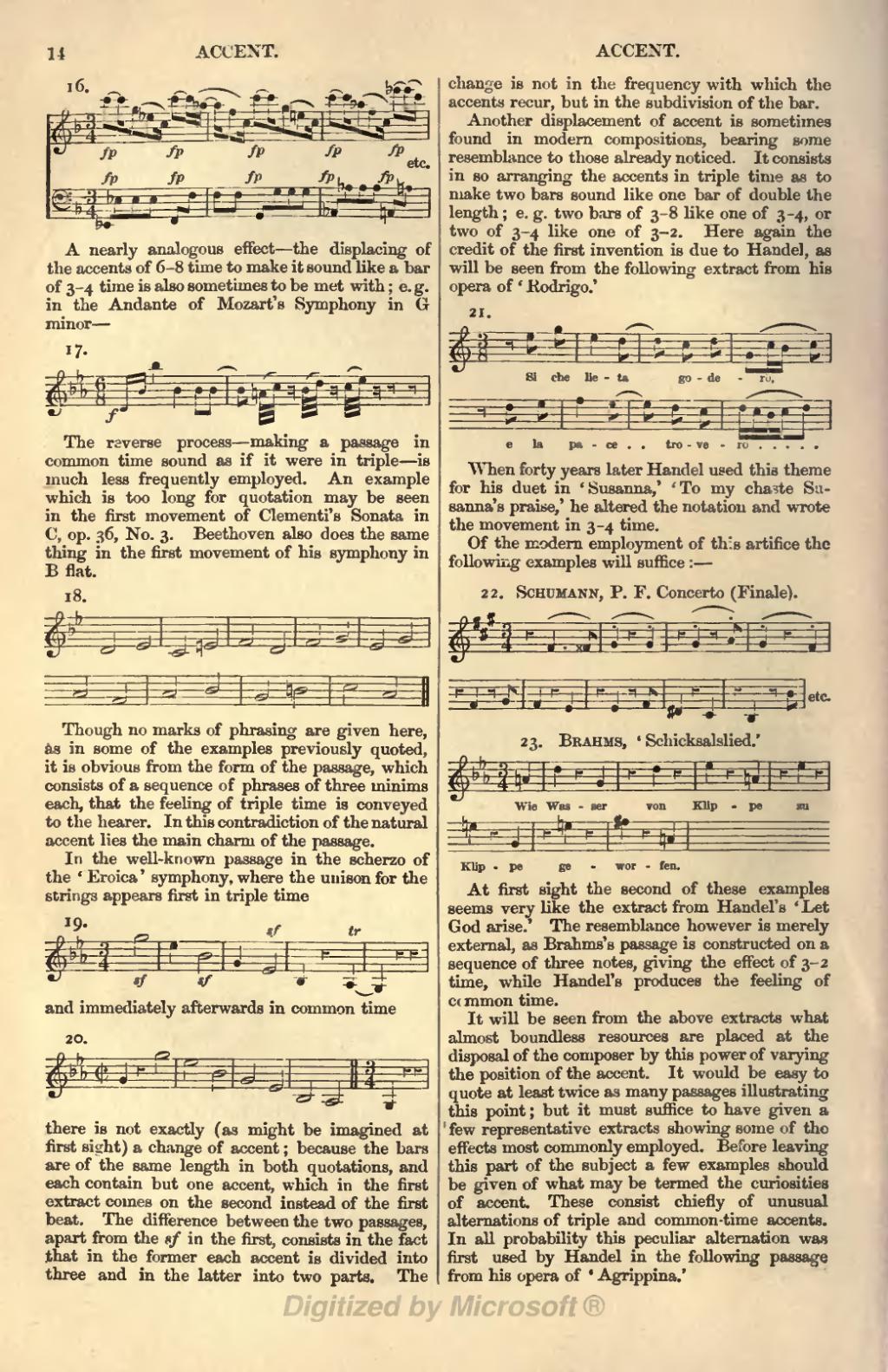![{ \time 3/4 << { \key f \major \relative c''' { \mark \markup \small "16." c8\fp[ ~ c16 g8( ees c16)] c'8\fp[ ~ c16( aes] ~ | aes[ f8 c16)] c'8\fp[ ~ c16 g8( e c16)] | c'8\fp[ ~ c16 aes8( f c16)] ees'8\fp[ ~ ees16( c)] | } }
\new Staff { \clef bass \key f \major \relative c, { ees8^\fp[ ees' ees ees] f,^\fp[ f'] | f[ f] g,^\fp[ g' g g] | aes,^\fp[ aes' aes aes] a,[^\fp a']^\markup { \null \raise #3 \smaller { etc. } } } } >> }](http://upload.wikimedia.org/score/k/6/k6xhmcy9l2uoaw39r7m76iso7ph7e7s/k6xhmcy9.png)
A nearly analogous effect the displacing of the accents of 6-8 time to make it sound like a bar of 3-4 time is also sometimes to be met with ; e. g. in the Andante of Mozart's Symphony in G minor—
![{ \time 6/8 \key c \minor \mark \markup \small "17." \relative c' { \grace { d16\f[ bes'] } bes'4 bes, bes8 bes ~ | bes a32([ c)] r16 bes32( d) r16 c32( ees) r16 r8 r | } }](http://upload.wikimedia.org/score/8/f/8ffsumctnmru0dv28v1crvs6724mf8t/8ffsumct.png)
The reverse process—making a passage in common time sound as if it were in triple—is much less frequently employed. An example which is too long for quotation may be seen in the first movement of Clementi's Sonata in C, op. 36, No. 3. Beethoven also does the same thing in the first movement of his symphony in B flat.

Though no marks of phrasing are given here, as in some of the examples previously quoted, it is obvious from the form of the passage, which consists of a sequence of phrases of three minims each, that the feeling of triple time is conveyed to the hearer. In this contradiction of the natural accent lies the main charm of the passage.
In the well-known passage in the scherzo of the 'Eroica' symphony, where the unison for the strings appears first in triple time

and immediately afterwards in common time

there is not exactly (as might be imagined at first sight) a change of accent; because the bars are of the same length in both quotations, and each contain but one accent, which in the first extract comes on the second instead of the first beat. The difference between the two passages, apart from the sf in the first, consists in the fact that in the former each accent is divided into three and in the latter into two parts. The change is not in the frequency with which the accents recur, but in the subdivision of the bar.
Another displacement of accent is sometimes found in modern compositions, bearing some resemblance to those already noticed. It consists in so arranging the accents in triple time as to make two bars sound like one bar of double the length; e.g. two bars of 3-8 like one of 3-4, or two of 3-4 like one of 3-2. Here again the credit of the first invention is due to Handel, as will be seen from the following extract from his opera of 'Rodrigo.'
![{ \time 3/8 \mark \markup \small "21." \relative c'' { \autoBeamOff r8 e g | e4 d8 ~ | d c d | g,([ c16 b] c8) | r d e | f4 e8 ~ | e d c | d16([ c b c d8)] | }
\addlyrics { Si che lie -- ta go -- de -- ro, e la pa -- ce __ tro -- ve -- ro __ } }](http://upload.wikimedia.org/score/i/c/ic002eutcsmnl21vw51b9cyr3k5e6tv/ic002eut.png)
When forty years later Handel used this theme for his duet in 'Susanna,' 'To my chaste Susanna's praise,' he altered the notation and wrote the movement in 3-4 time.
Of the modern employment of this artifice the following examples will suffice:
22. Schumann, P.F. Concerto (Finale).

23. Brahms, 'Schicksalslied.'

At first sight the second of these examples seems very like the extract from Handel's 'Let God arise.' The resemblance however is merely external, as Brahms's passage is constructed on a sequence of three notes, giving the effect of 3-2 time, while Handel's produces the feeling of common time.
It will be seen from the above extracts what almost boundless resources are placed at the disposal of the composer by this power of varying the position of the accent. It would be easy to quote at least twice as many passages illustrating this point; but it must suffice to have given a few representative extracts showing some of the effects most commonly employed. Before leaving this part of the subject a few examples should be given of what may be termed the curiosities of accent. These consist chiefly of unusual alternations of triple and common-time accents. In all probability this peculiar alternation was first used by Handel in the following passage from his opera of 'Agrippina.'

